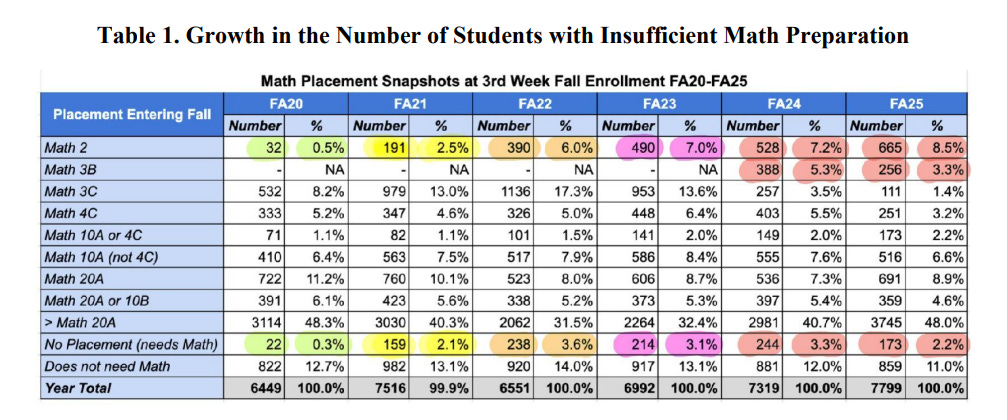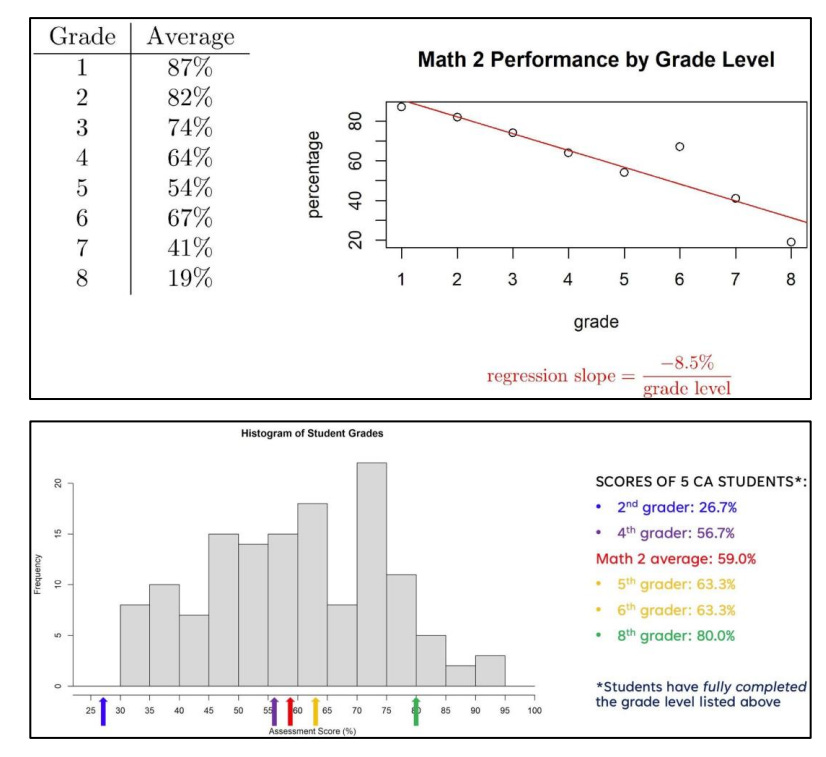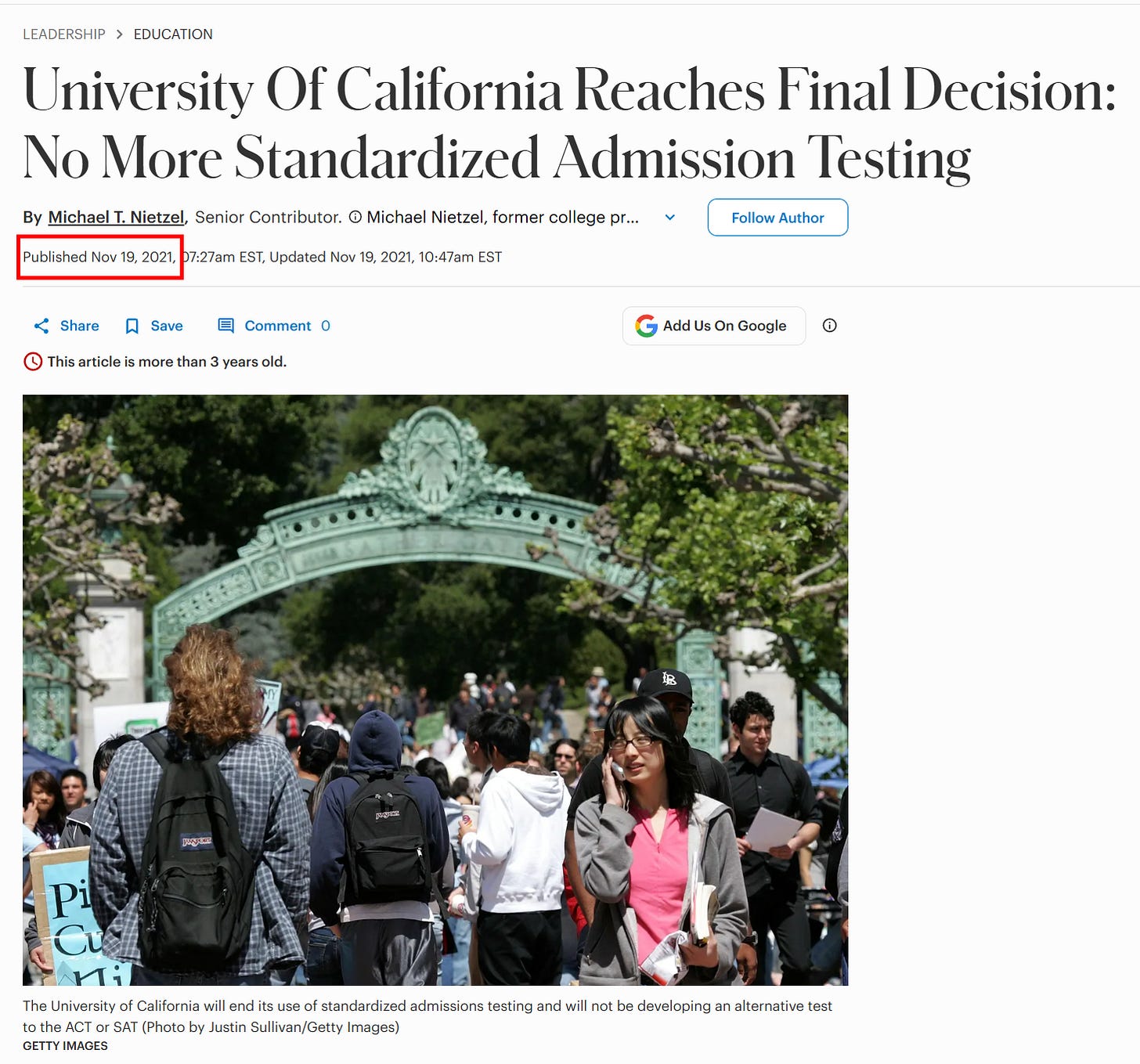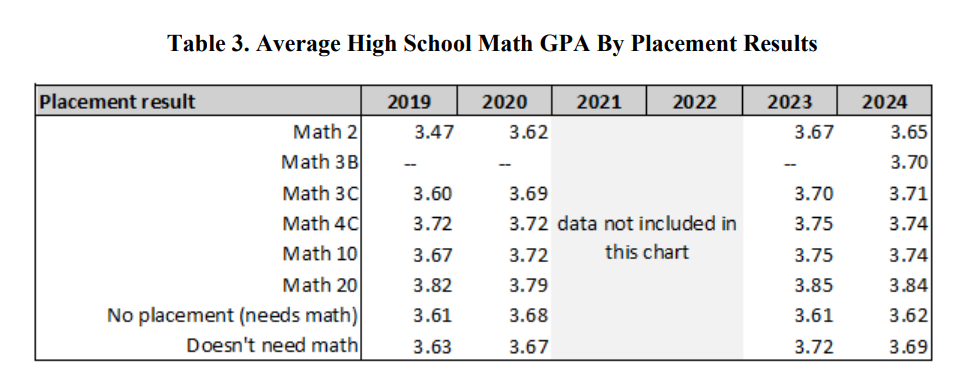College kids can't do math, either
UCSD is teaching elementary school math courses to freshmen. What happened?
Last week, the Senate-Administration Working Group on Admissions at the University of California San Diego released their report on the state of admissions at the university, and it’s grim. For the last couple years, over one in eight new freshmen couldn’t do high school math and needed remedial instruction.
The two remedial math classes, Math 2 and Math 3B, are both quite new, and teach math typically learned in K-8 and high school, respectively. But the naming is a little confusing: Math 3B is new as of 2024, and used to be called Math 2. It was the original remedial math course, and was introduced in 2016 to deal with a small number of admitted students who weren’t prepared for college-level math courses.
Math 2 was designed by the UC San Diego Mathematics Department to remediate skills gaps in high school mathematics topics (Grades 9-11), due to the observed need to provide a 10-week on-ramp for a small number of students to our normal precalculus courses (Math 3C and Math 4C). It was first offered in 2016, and from 2016-2021 it successfully served a small number of students (usually less than 100) that needed this additional support in their first quarter at UC San Diego before entering Math 3C or 4C.
The number of admitted students needing this remedial instruction remained small until 2020, after which enrollment ballooned.
Then things got worse: beginning in 2023, Math 2 instructors started to complain that their students were missing basic math skills from K-8 instruction.
In Fall 2023, the Math 2 instructors observed a new and alarming spread of skill gaps in the Math 2 students that quarter, with many severe gaps going back to mathematics taught in middle and elementary school.
Thus Math 2 was downgraded to K-8 skills, and the original Math 2 (high school skills) rebranded to Math 3B. Both were meant to address gaps in math knowledge for students who would need math in their prospective majors.
What kind of gaps? Here are sample questions from a test prepared by the math department to assess the skills of these remedial students, each labeled by the grade level of the skill and the percentage of such students who got it correct.
We’ll come back to these in a moment, but first let’s look at an overall summary of the results. Overall, only about half of the remedial students could claim 5th grade math ability, and only 19% had 8th grade skills.
Helpfully, the math department calibrated its grade level assessments by giving the same test to five public school kids in California — bright kids, one assumes, but K-8 students nonetheless. Their performances are marked by the colored arrows in the bottom chart, which demonstrate that the median score for remedial math students admitted to UCSD in 2023 is about on par with a 5th grader. For the 2025 school year, UCSD admitted 665 such students (on top of another 256 who couldn’t do high school math).
What happened? How did the quality of admitted students fall so far, so fast? The report spends a lot of time blaming poor kids for this outcome. No, really.
In 2013, the California state legislature introduced a supplemental funding framework for California K-12 public schools, the so-called Local Control Funding Formula (LCFF). The subset of California public schools in which more than 75 percent of the school’s total enrollment is composed of students who are identified as either eligible for free or reduced-price meals, or English learners, or foster youth, are eligible for additional funding through the LCFF program. The subset of California schools that meet these eligibility requirements are referred to as LCFF+ schools, and since 2016, University of California tracks enrollment from LCFF+ High Schools. The 2016-17 state budget for the UC system included “one-time funding for 19 support services for low-income students and students from underrepresented minority groups”. The one-time funding was intended to increase the number of applications, admissions, and enrollments from LCFF+ high schools to the UC, a contract signed by then President Michael Drake. Since 2017, each fall UCOP must submit a report on what UC has done to support LCFF+ schools.
So there’s legal and political pressure increase admission from schools with predominantly poor kids, and the UC system got a sweet kickback from the state legislature in exchange for agreeing to admit more of them. And for whatever reason, UCSD ended up with more of these academic albatrosses future scholars, starting in 2022.
UC campuses have participated unevenly in these changes to LCFF+ admissions and enrollments. In 2021, UC Riverside and UC Merced admitted the largest numbers of LCFF+ students, while Riverside and Irvine enrolled the most. Beginning in 2022, however, UC San Diego took the lead, with enrollment jumping from 894 in 2021 to roughly 1,800 in each of the following three years (2022-2024). By comparison, most other campuses saw only modest increases. UC Berkeley remained below 1,000, and UCLA below 1,100 LCFF+ enrollments.
For those not in the know, Riverside and Merced are the two down-market UC schools, admitting 76% and 91% of applicants respectively (compared to UCLA’s 9%). You won’t catch anyone wringing their hands about Riverside’s math skills, certainly not writing long mystified reports asking where it all went wrong. Their function in the system, the UCSD report seems to tacitly imply, is to absorb that kind of student so that the rest of the UC doesn’t have to deal with them. So what changed? Why did those students suddenly start getting into prestigious UCSD, traditionally the third-pickiest UC school, around 2021?
Oh.
So without standardized testing, how does the UC decide whom to admit? By a complex process they call “Holistic Review” or HR. The report dedicates 6 pages of dense, unbroken text to explaining this process without once describing what factors are included beyond high school GPA.
The process of our Holistic Review for first-year applicants can be divided into two stages. In the first stage, readers score each application with consideration of a range of factors derived from BOARS guidance.
There you have it, “a range of factors.” (BOARS apparently stands for Board of Admissions and Relations with Schools). They do mention that they have various statistical corrections to deal with grade inflation and inconsistent grading practices when appraising high school GPA, but otherwise that’s all you get, “a range of factors.” Or “a variety of other factors”, as below.
Beyond these highly quantitative factors, holistic readers are trained to look out for a variety of other factors that all conform within the BOARS list of approved considerations in admission and use the PIQs (a series of short essays) and activities lists to determine more about the student’s background, potential, and life experiences.
Every UC school, barred from using standardized test scores in admission, does something similar. So why is it that UCSD seems to be, uniquely among the elite UC schools, admitting so many dummies? Here I can only speculate, but my honest guess is that the UCSD admissions staff and administrators who oversee the program have a particular, shall we say, soft spot for certain kinds of “life experiences” that some students may have been wisely coached to include in their applications. But that’s just speculation.
More importantly, having recognized the magnitude and severity of the problem, what are they going to do about it? Remember, they cannot use standardized test scores in their admission process. Briefly: they recommend using a new model they invent called the Math Placement Outcome (MPO), which looks at applicants’ math grades and makes various adjustments for the student’s school. The big issue with this idea, which they do note, to their credit, is that a relatively meager difference in math grades separates students who can’t do algebra versus those headed straight into calculus. Specifically, 3.65 v. 3.84.
Recall that this average high school math GPA of 3.65 among Math 2 enrollees corresponds approximately a 5th grade level of math skills. Can the MPO find a signal in the 0.19 grade points that separate an A- in calculus from a being unable to name a triangle? Good luck!
It’s important to cut through the cope and HR-speak and discuss what these results actually mean. What does it mean that a quarter of remedial admits got this question wrong?
For some of the questions, such as simplifying complex expressions involving fractions, or expanding the square of an algebraic expression, you can will yourself to believe that an otherwise smart kid has been badly served by their math instruction, or has simply forgotten how to do that kind of problem in the years since being taught. But being unable to fill in a “3” in the box for the problem above? That points to a deeper deficit that can’t be described as a “gap” in understanding. There’s no trick to remember here, just an elementary level of symbolic reasoning and the ability to count. A student who can’t do this problem simply isn’t very bright, and is extremely unlikely to succeed in university courses absent radical dumbing-down and thumbs on the scale at every turn. That the university admitted about 200 such students last year should indict the entire admissions process.
The UCSD freshmen taking Math 2 are not to blame for their situation. They haven’t done anything wrong and shouldn’t be the subject of our anger or ridicule. There will always be a left-hand side of the bell curve, and somebody has to land there — in fact, half of all kids do. They’re not worse people because they’re less bright, and in fact they have every chance to achieve as much wealth and happiness as their brighter peers (IQ is correlated with income, but surprisingly weakly).
But they don’t belong in college, and they can’t be in college without radically changing what college is, what it’s for. This shouldn’t be controversial, and in most other universities, it’s not. Lots of colleges went test-free during covid and admitted whomever their hearts whispered they should, and in every case the result was a disaster, an unmanageable wave of unqualified freshmen who looked good on paper (or tugged at the heart strings just right) but couldn’t do the work. Nearly every university learned their lesson quickly and reversed course. California is uniquely stubborn in this respect, but now there are legal headwinds suggesting the UC schools will be brought to heel as well.
I find myself torn between sympathy for bright California high school kids being denied admission to give a spot to more sympathetic kids who can’t handle algebra on the one hand; and the fervent desire to see California maximally pursue these destructive policies as an object lesson to the rest of the country on the other. But what I know for sure is that things can’t go on like this forever, and so they won’t. If a university degree is to mean anything at all, then it must exclude those who can’t fill in the box.
Whether that happens before or after the UC system implodes is anyone’s guess. I’m rooting for you, UCSD.








But do they think there are dinosaurs roaming around the San Diego campus?
In CA I teach the new upper division math requirememt. 20% attrition normal.
There are Freshman admitted who cannot read, it is not a shock they fail at math. Not bad people, but they shouldn't be in university.